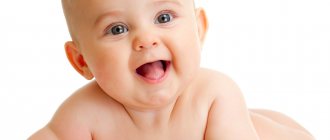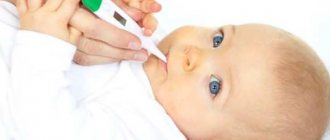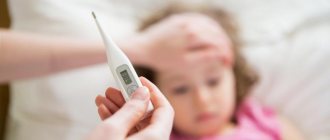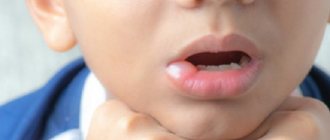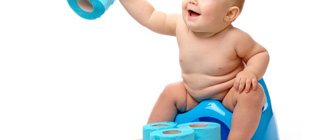Features of the skin of a child up to one year old
Human skin, regardless of age, is a two-layer “pie” in which the lower tier (dermis) is covered by the epidermis. It performs a protective function, so it itself represents a complex structure consisting of:
- basal;
- spiny;
- grainy;
- shiny;
- stratum corneum.
In the lower (basal) tier, cell division occurs, which slowly move to the surface. Along the way, they undergo a transformation: the core is lost and keratin accumulates. Having reached the top layer, the cells die, forming a stratum corneum of scales on the epidermis. They gradually disappear, being replaced by new ones.
Additional Information. In babies of the first weeks, the structure of the epidermis is different - instead of 5 layers, there are only 3 (basal, spinous and horny). Therefore, the movement process occurs faster, which is why the cells do not have time to change and become dense.
Baby's tender fingers
After a month, additional layers begin to form, but until the baby is one year old, the skin of a baby differs from that of an adult.
Characteristic features of baby skin:
- The epidermis does not interact strongly enough with the dermis. Because of this, the slightest inflammation leads to the formation of blisters.
- Up to 3 months, the epidermis does not have protective properties due to the fact that the pH of the skin is still neutral. The acidity level increases a little later.
- The skin glands are not yet capable of secreting a secretion with high bactericidal properties. This is another reason for the poor resistance of the dermis to microbes.
- The immature nervous system is not able to fully regulate the functioning of the sweat and sebaceous glands. Due to their low activity, the lipid layer is thin and unable to protect the dermis. As a result, the skin quickly absorbs moisture even after short contact with water.
- The skin itself also contains a lot of fluid. Blood vessels have thin, permeable walls. Against the background of immaturity of the systems (immune and central nervous system), this creates good conditions for the development of various skin allergies.
As the year approaches, the skin becomes less “transparent.” Due to the formation of additional layers, the epidermis becomes denser. The functioning of the glands is improved, the amount of water in tissues is reduced, and the acid balance is normalized. Gradually, the skin acquires protective properties and resistance to microbes.
Anatomy is closely related to physiology. This interaction has its own characteristics. Children's skin differs from adult skin not only in its protective properties.
Functional differences between children's and adult skin
| Skin function | Peculiarities |
| Respiratory | It is more developed than that of an adult - through the pores, oxygen enters the baby’s body 10 times more. This is facilitated by the numerous vessels in the dermis and the high permeability of the epidermis |
| Suction | Due to the thin lipid layer, products for external use are well absorbed, which speeds up the process of action of the drugs. But many creams and ointments applied to a baby’s skin form a dense crust on it, making breathing difficult. |
| Thermostatic | The immaturity of the sweat glands makes the function imperfect. Therefore, the toddler easily becomes hypothermic or overheated. |
| Synthetic | Under the influence of ultraviolet radiation, the skin produces beneficial substances that enter the body (among them vitamin D). The function begins to manifest itself by the end of the first month of life |
A baby's skin contains many receptors that are more sensitive than those of adults. This makes tactile contact quite noticeable and allows the tactile function to maximally fulfill its role - to interact with the environment.
Causes
Before using moisturizing creams, it is important to understand the causes of peeling skin on the baby’s palms and feet. This can only be done by a doctor after laboratory tests.
If there is a one-time, short-term manifestation of the pathology, there is no need to worry. However, if peeling is constantly detected, and with significant intensity, qualified medical assistance is required.
Diseases
Often the skin on the fingers peels off due to pathologies of the internal organs. One of the reasons is pancreatic disease. Pancreatitis is provoked by poor nutrition, inflammation, abnormalities of the digestive system, medication abuse, and injury to the abdominal wall. The disease is getting younger every year, and children are increasingly affected by it.
Pathological dryness occurs with diabetes, hormonal imbalances, and dermatitis. These disorders lead to a significant reduction in the production of lipids by the sebaceous glands of the epidermis - organic compounds that affect the retention of moisture in the tissues. With their deficiency, fluid deficiency occurs, the skin dries and peels.
Frostbite
The skin on a child’s fingers may peel off due to the influence of external factors - prolonged exposure to the cold. Frostbite of the extremities can occur from too tight mittens or narrow shoes that interfere with normal blood circulation; from high air humidity, contact with snow, which causes clothes to get wet and overcool the body.
Stress
Stress affects children's nervous systems in different ways, sometimes leading to skin peeling. The neurological cause in young children is more difficult to establish, since children are not able to verbally share their experiences.
It is necessary to analyze how the child sleeps, who he is friends with, and what he eats. Also, anxiety may not be associated with external factors, but with the characteristics of the child’s psyche.
Read: Diet for atopic dermatitis: rules for creating a diet
Consequences of therapy
Therapeutic measures associated with therapeutic radiation can lead to peeling of the epidermis. Ultraviolet radiation destroys all microbes on the surface of the body, including those responsible for the production of fat.
Due to such procedures, the skin dries out and then peels off. Children taking long courses of antibacterial and hormonal drugs very often suffer from desquamation.
Poor hygiene
An atypical factor in peeling of the epidermis is lack of personal hygiene. Poorly washed fingers after a walk lead to the accumulation of dirt in the interdigital space, which causes itching and subsequent peeling.
Bad heredity
Not only genetic pathologies are inherited. Poor tooth enamel, thin hair, skin prone to peeling - all this can be passed from one of the parents to the child even before his birth.
Allergy
Often the skin on a child’s toes and hands peels off as a response to an allergen. Allergies can be triggered by food, household chemicals, plants, or animal hair. In any case, it is important to first eliminate the allergen itself, and only then deal with desquamation.
Avitaminosis
Peeling of the skin on the feet and palms occurs due to a deficiency of microelements in the body. The peak of vitamin deficiencies occurs in winter and spring, when reserves of useful substances are exhausted, and it takes time to accumulate new ones.
Worm infestations
Problems are caused by intestinal parasites, which feed on nutrients through the intestinal walls to maintain their active life. When a child is affected by helminthic infestations of pinworms, roundworms, and lamblia, desquamation may occur.
Fungus
The most common cause of peeling skin on the feet is a fungal infection. With fungal diseases, cracks and detachments of keratinized particles appear on the skin, not only around the toes, but also on the entire sole.
Without timely treatment, the hands, head, and nails are affected. A characteristic sign of a fungal infection is the clarity of the affected areas, their painful redness, itching, and intense peeling.
What causes peeling skin on a child’s fingers?
Sour smell of stool in a child under one year old - causes of stench
The above-mentioned skin features of young children often cause problems that appear on the epidermis (infections, inflammation, cracks, peeling, etc.). Among other things, it is worth considering the factors that cause the skin on a child’s fingers to peel off.
Allergy
Such a manifestation may be a reaction to cosmetics, detergents, and laundry products. Peeling of the epidermis often results from food allergies to citrus fruits, strawberries, chocolate, eggs, honey, etc. Allergens can also include pollen from certain plants and animal dander.
Avitaminosis
If the skin on the baby’s palms begins to peel off, one can suspect a malfunction of the synthetic function - the body does not produce enough vitamins A and E. A deficiency of tocopherol and retinol can also be associated with poor nutrition of the baby.
Keratolysis
Most often, peeling skin on the fingertips of infants occurs seasonally: in spring and autumn, this is due to a lack of vitamins. In other situations, provoking factors include excessive sweating, exposure to friction or chemicals on the skin.
In the latter cases, air-filled bubbles first appear on the body. They quickly open; the edges of the burst blisters do not adhere to the upper layer of the epidermis.
Skin infections
Infectious diseases such as scabies, lichen, and fungus can lead to peeling skin in a child. They are dangerous for small children, and therefore require timely intervention from a doctor.
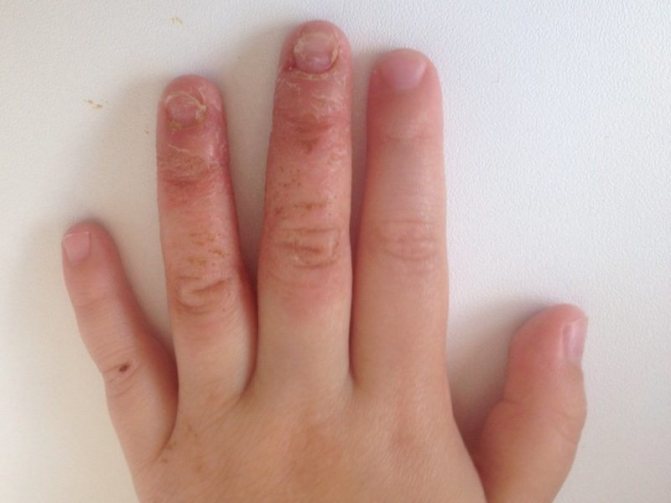
Fungus in a child
Scarlet fever
The infection affects the entire body. Peeling of the skin is one of the accompanying signs that can appear not only during the process, but also after the baby has recovered.
Heat exchange
If the little one is too wrapped up, the heat exchange balance is disrupted. A newborn sweats a lot from overheating, causing the skin to stop breathing. The abundance of sebaceous secretions leads to the development of inflammatory processes in the epidermis, manifested by peeling of the skin.
Stress
Newborn babies have a rather unstable psyche; the slightest negativity can lead to stress. The emotional background is one of the reasons why the skin on a child’s hands peels off.
Contact with soap
Skin problems can be caused not only by poor hygiene, but also by abuse of it. If your baby's hands are washed too often with soap, this removes oils, which makes the skin dry. Fanaticism causes not only peeling, but also the skin can crack.
Dysbacteriosis
The problem affects the intestines, but can appear on the baby’s palms. This is due to the use of antibiotics in the treatment of the child. Suppression of beneficial microflora leads to the failure of many functions in the body. The skin is also not left unattended.
Helminths
Helminthic infestations manifest themselves with various symptoms. One of the signs of damage is peeling skin on the palms.
Why does the baby's skin peel off on his arms and legs, the main reasons
The skin on the hands is most susceptible to the negative effects of the external environment.
Compared to other areas of the body, the skin on the handles has a small amount of sebaceous glands and moisture, which are necessary to give it elasticity and smoothness.
If in a child it becomes dry, begins to peel, redness and spots appear, and then wounds and cracks, then first of all it is necessary to identify the cause of this phenomenon and eliminate it. Don’t delay; it’s better to go to a specialist in time and, if necessary, get tested to make a correct diagnosis.
The main reasons include:
- Incorrect care. Frequent exposure of the baby's hands to water, frost, and wind. If the skin on your hands is too dry, it must be additionally moisturized using regular baby cream;
- Excess moisture. If the baby’s hands often come into contact with water, the skin begins to peel off, the skin begins to peel off between the fingers;
- Avitaminosis. This phenomenon can occur due to a lack of vitamins A and E in the body. Vitamin deficiency often manifests itself in the autumn-spring period, when the supply of useful nutrients in the body is depleted. You can restore the supply of vitamins and minerals with the help of products containing various vitamins and minerals (carrots, carrot juice, vegetable oils), vitamin complexes, and oil solutions of vitamins. They are given to the child on an empty stomach in the morning, or you can drop a couple of drops on some bread;
- Climatic conditions. The skin on the fingers may peel off due to the dry air of heated rooms in winter. In summer, it peels off due to exposure to ultraviolet radiation;
- Allergy. An allergic reaction in a child can occur to paints, modeling clay, plasticine, scented soap, powder, and shampoo. Allergies can also be caused by foods and various medications he takes. Here it is important to identify the allergen in time and exclude it;
- Disruption of metabolic processes within the body. The epidermis on the fingers may peel off due to the fact that your child’s metabolic processes within the body are disrupted. Because of this, it may become dry and begin to peel;
- Skin diseases, fungus. Due to the development of various diseases of the epidermis, the baby may also peel off the skin on the fingers and toes. Here it is important to undergo an examination by a dermatologist and establish the correct diagnosis;
- Infectious diseases. Scarlet fever can cause dryness and peeling of the epidermis on the palms and soles;
- Action of antibiotics. Antibiotics can cause digestive disorders and disruption of intestinal microflora. These processes affect the state of the epidermis. Here you need to give “Bifidumbacterin”, “Linex” and other lactobacilli;
- Stressful situations. The emotional state of a child affects his health. If there are constant conflicts in the family and the child experiences severe stress, he may have nervous breakdowns. And because of them, problems with the epidermis begin, the skin peels off the arms and legs.
There may be other reasons. To protect your child from diseases, you need to take care of him, pay due attention to the health of your baby and, if necessary, consult a doctor in a timely manner. What should you do if the skin peels off between your child’s toes and hands? What actions to take and how to treat?
Types of skin peeling
Dark urine in a child - causes of concentrated urine
There are several reasons why the skin on a child’s hands peels off. Therefore, it is easy to make a mistake in diagnosing the problem and choosing the wrong direction to eliminate it. A description of the types of peeling will help you navigate the situation:
- with food allergies, the process is accompanied by itching, but the symptoms quickly go away if the cause of the problem is removed from the diet;
- in case of contact allergies (for example, a reaction to soap or cream), peeling affects the fingers, palms, and the back of the hand;
- if the chemical exposure was single, then the skin will peel off only at the point of contact (the child got a chemical substance on his finger or palm);
- that the reason lies in infections can be understood by the temperature fluctuations that accompany the course of the disease;
- if the skin sheds profusely at the junction of the fingers, scabies is suspected;
- peeling on the sides of the phalanges indicates the presence of a fungus;
- sometimes the skin peels off in spots, in this case the reason can be judged by the color of the mark:
- with psoriasis it is silvery-white;
- dark gray color is a sign of ichthyosis;
- lichen appears pink or red;
- If a child’s fingertips not only peel, but also crack, this may be evidence of a lack of vitamins.
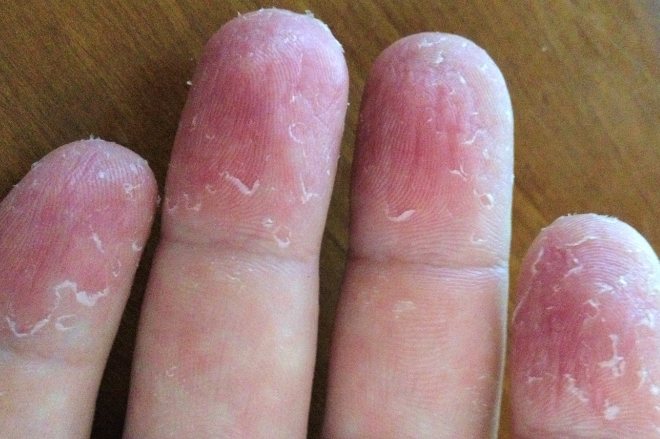
Suspicion of vitamin deficiency
In most cases, the pattern of peeling on each hand manifests itself differently. If the skin begins to peel off symmetrically on both limbs, the cause should be sought inside the body (infectious diseases, malfunctions of the digestive system).
Possible causes of peeling
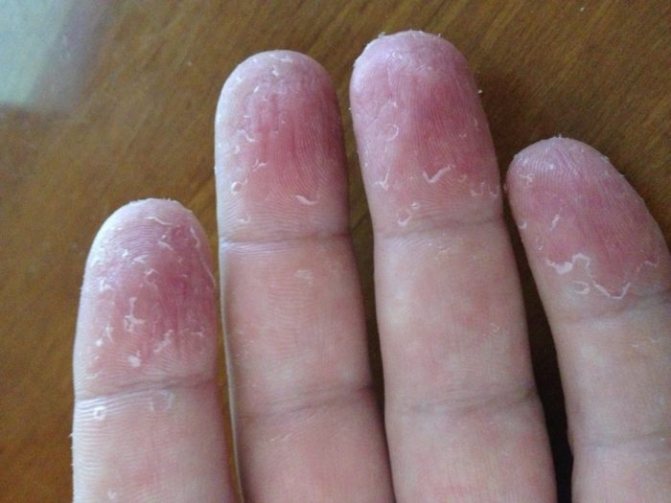
If a child has peeling skin on his fingers, the first thing doctors suspect is a lack of vitamins of a certain group. There are a number of situations in which the baby suffers from disorders in the digestive system, and all the vitamins supplied with food cannot be fully absorbed. Accordingly, the skin on the child’s fingers cracks and heals slowly, because the body lacks vitamin A and E.
The skin on your hands will also peel off during an allergic reaction; it can be triggered by both household chemicals and food. Parents should remove potential irritants from the child’s environment and review the diet. Taking medications such as sulfonamides, glucocorticoids and antibiotics reduces the baby’s immune strength and can cause peeling and cracks in the fingertips.
It is not uncommon for a child to peel off the skin on his fingers, and all this is accompanied by symptoms such as:
- refusal of food;
- moodiness;
- sleep disturbance;
- stomach ache;
- defecation disorders.
In such situations, the doctor will send you for a stool test, because most likely the reasons lie in helminthic infestations. Parasites absorb all the beneficial substances that the child receives and deplete the body, so the skin is the first to react.
The child’s fingers will peel due to a fungal infection. A child can catch it anywhere, even while playing with shared toys in kindergarten, but in most cases children become infected from their parents. That is why it is so important for adults to monitor proper hygiene and their health if there is a child in the house. In the case of a fungal infection, in addition to peeling, the child’s fingers show:
Instructions for using Keto Plus shampoo and cheap analogues
- cracks;
- small papules;
- sores;
- the baby complains of itching and burning;
- there is increased dryness of the skin;
- foci of inflammation spread to new areas;
- Over time, the rash area hardens and becomes crusty.
Similar symptoms are observed if a child has peeling skin on his fingers due to a streptococcal infection. The only difference is that the clinical picture will be supplemented by fever and sore throat.
In newborns and infants in the first month of life, peeling of the skin on the arms and fingers is a normal situation that does not require intervention. The baby and his body thus adapt to the new environment. After a couple of weeks, the skin should return to normal.
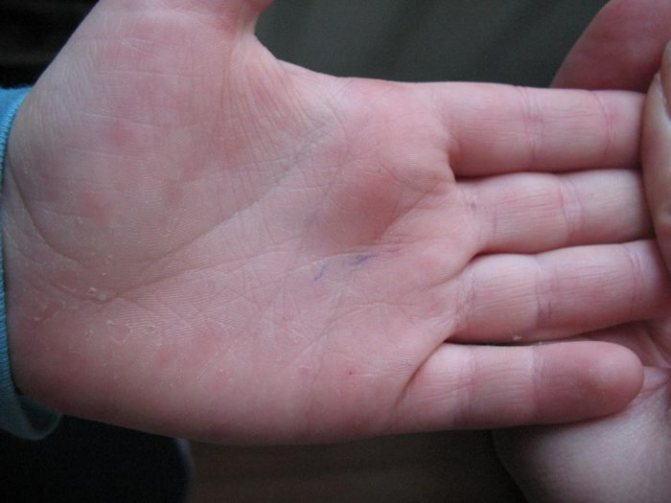
The skin on the fingers also peels off with photodermatosis. This is a kind of allergic reaction to exposure to ultraviolet rays; it can be caused by a significant decrease in immunity or be an innate sensitivity of the skin. You can recognize photodermatosis by the fact that when a child goes out into the sun, his skin becomes covered with a small rash, turns red, peels, and even ulcers form. Parents, having confirmed the diagnosis in the future, should treat the skin with special sunscreens to avoid severe burns and even anaphylactic shock.
The causes of the pathological condition of the epidermis on the fingers may be hidden in improper child care. Excessive use of alkaline soap, as well as a rough towel, can damage the top layer of delicate skin and cause it to peel. The skin of the fingers begins to peel off after frostbite, for example, after playing snowballs without gloves, maceration of the skin of the fingers and hands may be observed on the fingers. This condition does not require medical intervention; it is enough to apply a nourishing cream.
Sometimes, by the appearance of peeling, you can determine what kind of disease is progressing in the body. Of course, tests will have to be taken in any case, but the doctor will still understand which direction to move in order to determine the disease. If the skin between your fingers peels off, it could be scabies. In case of peeling on the sides of the fingers, a fungus can be assumed. Psoriasis and lichen can be diagnosed if the peeling is white or pink and is localized in separate spots on the fingers and palms. Dark spots indicate ichthyosis.
As can be seen from the above, the reasons for peeling skin on the fingertips can be different, but self-diagnosis, especially when it comes to a small child, is not only stupid, but also dangerous. With your thoughtless attempts to improve the situation, you can significantly harm the baby.
Ways to Diagnose Symptoms
Leukocytes in the stool of a child under one year old - the norm, reasons for the increase
The specialist decides what diagnosis to give the baby. A visual examination in this case is not enough. A number of other measures will need to be taken:
- pass:
- a smear or scraping of the skin from and around the damaged area;
- blood tests to detect the presence of an infectious disease;
- culture to determine the presence of helminths;
- be examined by specialists: gastroenterologist, endocrinologist, allergist, dermatologist, neurologist.
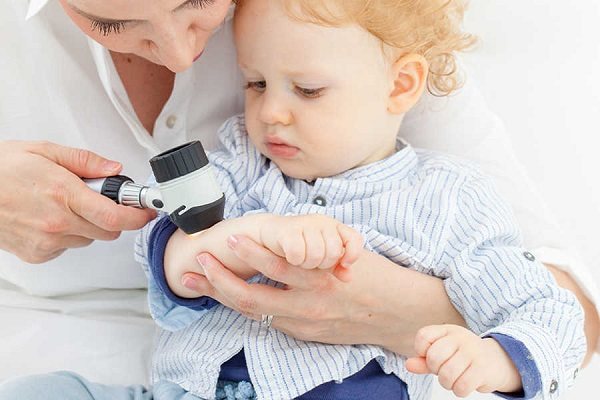
At an appointment with a dermatologist
The previous treatment of the toddler is taken into account, and it is specified which antibiotics were included in the course of therapy. If scabies and other skin infections are suspected, all family members are examined and the household environment in which the baby develops is studied.
Prevention
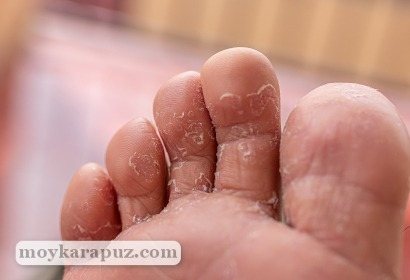
To avoid skin peeling on your baby’s toes, it is recommended:
- constant hygiene procedures;
- avoid cracking and dry skin: apply a suitable cream to your feet, take herbal baths;
- feed healthy food, fresh fruits, vegetables;
- give vitamin complexes recommended by your doctor;
- purchase high-quality children's shoes, abandon synthetic fabrics;
- promptly identify infections, helminthic infestations and treat them;
- treat all scratches and wounds, even small ones;
- harden, conduct physical education classes.
The skin on a child’s toes can peel off for a variety of reasons. This situation should not go unnoticed by parents, because even slight peeling can be a sign of a serious illness. It should be treated only after consultation with a pediatrician.
Views:
20060.
Baby skin care tips
To avoid the problems described, Dr. Komarovsky recommends preventing them by following certain rules.
Hygiene recommendations
Water procedures are a prerequisite for caring for a baby. Even if a newborn cannot crawl yet, his skin will peel when the baby is occasionally bathed. This procedure is necessary - it helps to wash away “extra” particles of the epidermis from the surface.
Since in infants the process of cell movement occurs faster, they need to be bathed more often (but not overdo it), adding decoctions of chamomile, oak bark, nettle, string or calendula flowers to the water. At the same time, choose the right soap that does not cause dry skin.
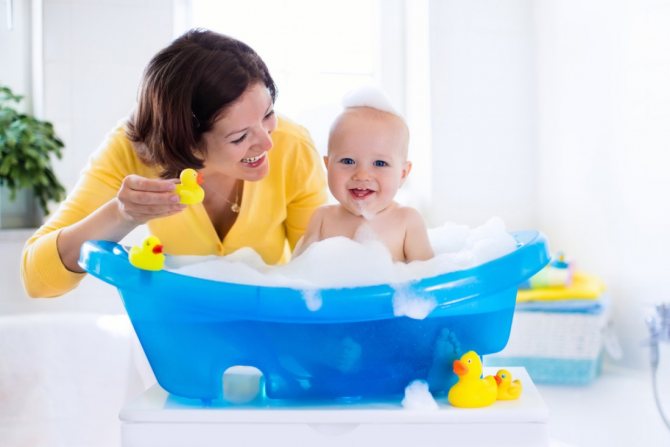
Important procedure
One of the points of hygiene is trimming nails. In newborns, the plates, although soft, are quite capable of scratching delicate skin. An infection will get into the wounds, resulting in an inflammatory process.
When the problem has already arisen, an overgrown nail aggravates the situation. When itching, the baby itches, tears the skin in the affected areas, allowing microbes to penetrate deeper into the dermis. In this case, you will have to put special gloves on the little one.
Maintaining moisture balance
Sometimes the skin can peel off because it has become too dry. The main reason here is a violation of tissue hydrobalance. The human body is 70% filled with water. The fluid is quickly consumed (excreted in the urine, sweat), so regular replenishment is required.
For breastfed babies, mother's milk compensates for the lack of moisture - it also contains a high percentage of water. With the introduction of complementary foods, the need for an additional source of fluid arises.
Note! The baby’s health directly depends on the water-salt balance. Therefore, if the little one begins to urinate a little, this is a signal that a malfunction has occurred in the body. Peeling of the skin will confirm this.
A thirsty child will not be able to explain to his mother on his own that he wants to drink. Starting from six months (earlier for artificial babies), after the main feeding, the child is given baby water in small portions.
Moisturizing creams produced specifically for babies will help maintain the hydrobalance of dry skin. They should contain linseed oil, sea buckthorn or peach.
Getting the Vitamins You Need
Each cell of the skin requires energy, which is impossible to obtain with poor nutrition. Complete mother's milk and infant formula fill the body with all the vitamins necessary for the child's development.
Note! Partial and then complete transfer of the baby to adult food can provoke vitamin deficiency, one of the signs of which is peeling of the skin.
Vitamins A and E play an important role in the elasticity of the epidermis. Therefore, carrot, pumpkin, plum, peach puree and juices should be present in the baby’s diet. When the time comes for protein complementary foods, the child is periodically given liver, fish and eggs regularly. Potatoes, oatmeal and corn porridge are useful as a side dish for the skin.
Particular attention is paid to the diet at the turn of the seasons. It is during the transition from autumn to winter and the latter to spring that the body most often experiences a deficiency of vitamins, which causes the baby’s immunity to become compromised.
Care during the cold season
Small children are always carefully wrapped up for walks in cool weather. Therefore, the risk that the little one’s hands will freeze is minimal. In this case, overheating often has a negative effect on the dermis. The child’s palms sweat a lot, disrupting the water-salt balance in the cells. Diaper rash causes itching, causing discomfort in the baby.
Children should be dressed according to temperature. At the same time, they should be warm, but not hot. Mittens are chosen from natural material that does not provoke skin friction.
fingertips are cracking
An invention of the Chinese, the Su-Jok method of self-massage of hands and feet is a phenomenon of positive impact on biologically active points of a person. Each such point represents a certain projection of a certain internal organ. Both the hand and the foot resemble a model of the human body in terms of the location of the active points on them. By rubbing or massaging our palms and feet, we thereby influence the internal organs, preventing the development of diseases or their exacerbations. Su-jok is useful , because self-massage can help avoid colds, cure coughs, eliminate pain in the lower abdomen, get rid of constipation and reduce swelling.
What is a biologically active point and how does pressing work?
When you feel a place near a biological point, you may find a lump, a pit, or soreness. If pain occurs when pressing, it means you have found the right point. When you massage or press on a point, you trigger an electrical signal wave that is transmitted along the meridians of the body to the diseased organ. After a second, a response “therapeutic” reaction occurs in the organ, which stimulates the work of the organ, the vessels and nerves approaching it. Treatment with seeds comes down to consolidating the positive effect on the point and organ with the seed. Seeds in su-jok act as magnets that emit biological waves. Seeds attached to biologically active points transfer their vital energy to the organs and repel diseases.
How does seed treatment work?
Medicinal seeds can be used in two ways.
- Massage your hands and feet with seeds , using them as stimulants and massagers.
- Attach the seeds to the points in the form of an applique. After massaging the point, the seed should be glued to the point with a piece of adhesive tape and left overnight, and replaced with a new seed in the morning.
If you have already been treated with seeds before, you probably noticed that in the morning the seed changes greatly - it becomes soft, brittle, cracks, turns black, and changes size. All these changes indicate that the seed is actively “healing” the diseased organ. If the place where the seed is glued hurts, it means that the healing process is underway. Gradually the pain will subside. By the way, it is recommended not to throw away the seed, but to bury it so that the disease does not return.
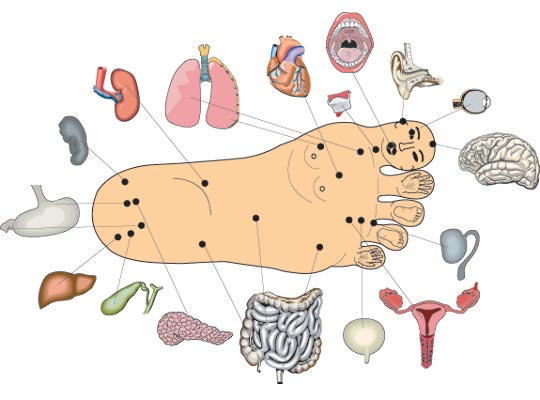
Rules for choosing seeds for su-jok
The seeds must be intact and able to germinate.
Seeds need to be selected depending on the organ you want to influence:
- Round - for eyes, head, mammary glands;
- Bean-shaped - for the kidneys;
- Pear-shaped - for the gallbladder;
- Buckwheat - for the heart;
- Grape seeds are for the pancreas.
Depending on the effect of exposure:
- Seeds of watermelon, melon, and parsley have a diuretic and anti-inflammatory effect;
- Hawthorn seeds have a calming effect if applied to areas of influence on the brain and normalize the functioning of the cardiovascular system if glued to the heart area;
- Bird cherry seeds help with diarrhea, etc.
Su-Jok and seed treatment during pregnancy
Look carefully at the “map” of the points on the palm and foot.
Now we use su-jok methods and seed treatment depending on the problem that bothers you during pregnancy.
Lower abdominal pain . The set of points of the organs of the uterus, bladder and ovaries is located at the base of two fingers: the ring and middle. The projection is similar for the feet. For successful pregnancy, su-jok specialists recommend “blocking the cervix” by passing the thread between the fingers and thus pulling the hand. Thus, the area of the uterus and ovaries will be constantly in active mode. Swelling, high blood pressure, poor kidney function. The points responsible for the kidneys are located on the right and left on the outer side of the hand, almost at its base. Constipation, digestive problems. You need to glue apple or cumin seeds to the corresponding area of the large intestine. There are several such points: one of them is in the center of the palm and foot, and the other is located on the outer edge of the foot closer to the heel. The heel, by the way, is very densely “populated” with active points that are responsible for digestion. Toxicosis, nausea. We stimulate and rub the liver area, the point is on the heel and at the base of the hand on the right side. Dizziness, weakness, drowsiness. We stimulate the points at the base of the nail plates on the hands. If you get tired quickly, you need to rub and massage the points responsible for the brain and cervical region. Cold. It is necessary to activate the areas of the throat, nose and ear, which are located on the pads of the fingers and big toes. Temperature. A high temperature is dangerous for the expectant mother, therefore, without resorting to medications, you can alleviate the condition by doing the following:
- Stick a pear seed or rice to the tips of your fingers. You can also apply ice for 1-2 minutes, and then paint the ends black with a felt-tip pen or marker.
- On your index finger, draw a line with a black felt-tip pen from the edge of the nail plate to the middle joint. And think about how your temperature drops.
Cough. We stimulate the area of the lungs and larynx. The points are located at the base of the thumb on the hands and toes.
How and when to use su-jok methods during pregnancy?
First trimester of pregnancy. The laying and formation of all the internal organs of the child is underway. The mother's body is just getting used to these changes. Su-jok and seed treatment sessions are recommended to be carried out 1-2 times a week. Pair your sessions with soothing herbal tea and relaxing music. If a certain problem arises (toxicosis, colds, swelling, threat of miscarriage), then you need to massage, knead the points and glue the seeds daily, and when the condition improves, continue 1-2 times a week. Important! Using su-jok methods during pregnancy does not mean stopping the medications your doctor prescribed to you.
Second trimester of pregnancy. From the 18th week, to prevent colds and increase immunity, you can do a su-jok massage and attach seeds to the points 3-4 times a week.
Third trimester of pregnancy. Mom’s body is especially susceptible during this period, so if you are not concerned about your well-being, then reduce su-jok sessions and the number of nights with a seed on your hand to once a week.
Dangerous symptoms that require visiting a doctor
When a child has slight flaking on the palms of their hands, the back of their hands and near their fingers, this may be a sign of an allergy to food, detergent or poor-quality cream. It is possible to cope with the problem on your own by eliminating the main factor.
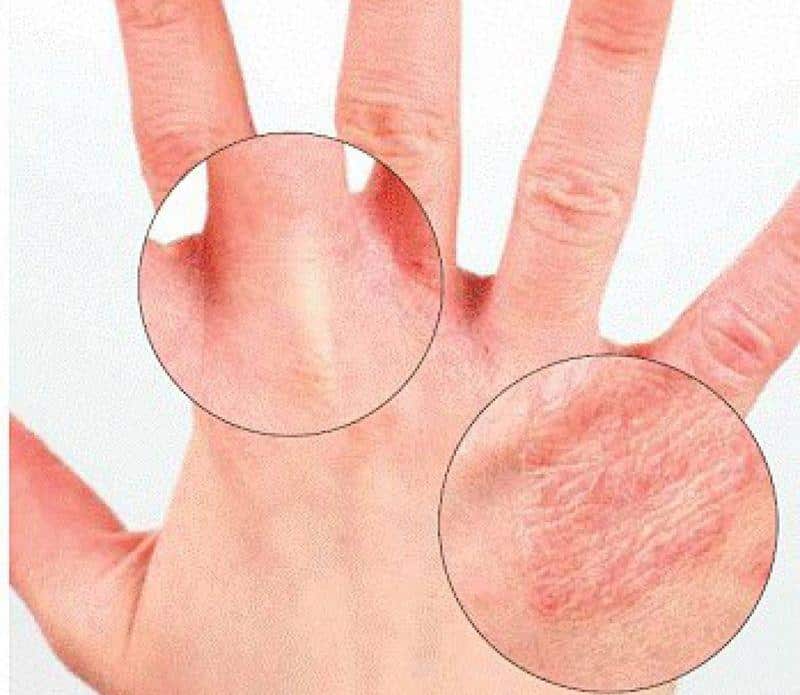
Dangerous symptoms
If the skin begins to burst and hang down in scabs, this is already a reason to look for a serious reason that may be hiding inside. Such symptoms cannot be ignored by specialists.
Dangerous signs that require immediate medical attention are severe itching, fever, blisters or pustules on the skin, and constant crying of the baby. They may indicate not only the development of skin diseases, but also be a symptom of a malfunction of the liver, pancreas and digestive system.
Treatment
If the skin peels off without visible external reasons, the reason probably lies in a problem with the internal organs; you need to contact a specialist who will prescribe a diagnosis, and based on its results, the correct treatment.
If dryness and flaking are caused by cold in winter, it is enough to follow the following recommendations:
- Restore the body's water balance. The normal volume of fluid consumed per day is 2-3 liters. It can be fruit drinks, water, tea, juices, broths.
- Kids love to frolic outside; due to hypothermia, their skin cracks and peels. Special moisturizing creams and ointments nourish sensitive skin, soften and protect it from damage. Before each walk, you need to lubricate your child’s hands with this product. However, creams for adult skin are not suitable for children.
- Together with your pediatrician, you need to select a vitamin complex in capsules or tablets. During periods of shortage of useful components in products, it will replenish their balance in the body.
- Consider the content of vitamins A and E in the child’s diet; there should be enough of them.
If the described recommendations do not help, you should immediately consult a doctor. So, moisturizing creams do relieve the symptoms, and the flaking may disappear for a while. However, these same ointments are fertile ground for the proliferation of scabies mites and aggravate the condition of a small patient with atopic dermatitis. For diseases of the digestive system, infectious diseases, and worm infections, urgent, competent drug therapy is needed.
Read: A spot on a child that looks like lichen: possible diseases
Self-medication is unacceptable! Only a doctor is able to correctly diagnose, calculate the correct dose of drugs and determine their course of administration.

